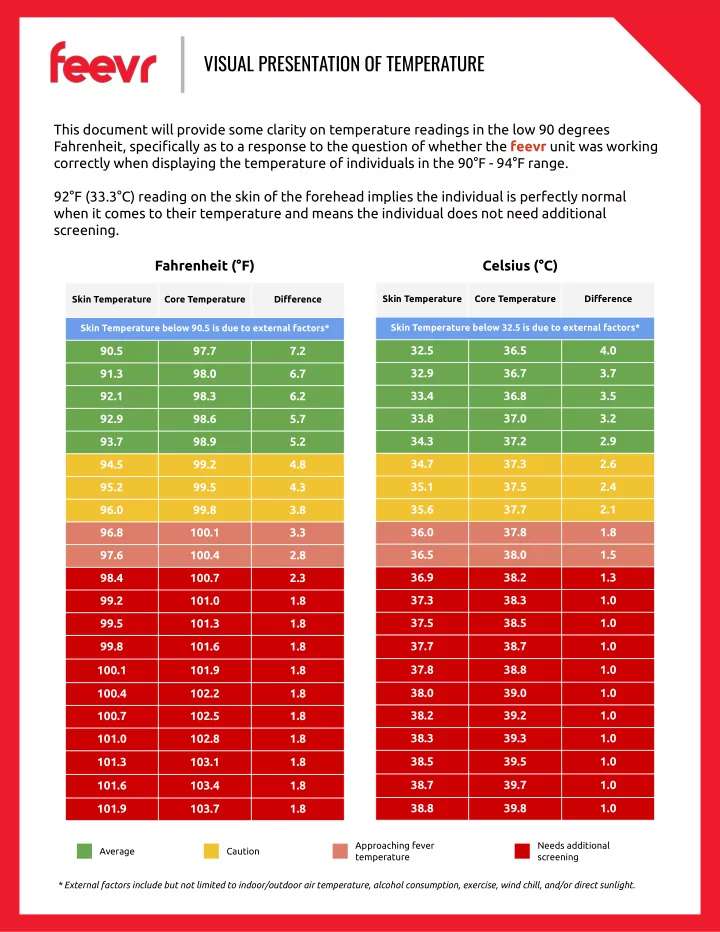

VISUAL PRESENTATION OF TEMPERATURE This document will provide some clarity on temperature readings in the low 90 degrees Fahrenheit, specifically as to a response to the question of whether the feevr unit was working correctly when displaying the temperature of individuals in the 90°F - 94°F range. 92°F (33.3°C) reading on the skin of the forehead implies the individual is perfectly normal when it comes to their temperature and means the individual does not need additional screening. Fahrenheit (°F) Celsius (°C) Skin Temperature Core Temperature Difference Skin Temperature Core Temperature Difference Skin Temperature below 32.5 is due to external factors* Skin Temperature below 90.5 is due to external factors* 32.5 36.5 4.0 90.5 97.7 7.2 91.3 98.0 6.7 32.9 36.7 3.7 92.1 98.3 6.2 33.4 36.8 3.5 33.8 37.0 3.2 92.9 98.6 5.7 93.7 98.9 5.2 34.3 37.2 2.9 94.5 99.2 4.8 34.7 37.3 2.6 35.1 37.5 2.4 95.2 99.5 4.3 96.0 99.8 3.8 35.6 37.7 2.1 96.8 100.1 3.3 36.0 37.8 1.8 36.5 38.0 1.5 97.6 100.4 2.8 36.9 38.2 1.3 98.4 100.7 2.3 99.2 101.0 1.8 37.3 38.3 1.0 37.5 38.5 1.0 99.5 101.3 1.8 99.8 101.6 1.8 37.7 38.7 1.0 100.1 101.9 1.8 37.8 38.8 1.0 100.4 102.2 1.8 38.0 39.0 1.0 100.7 102.5 1.8 38.2 39.2 1.0 38.3 39.3 1.0 101.0 102.8 1.8 101.3 103.1 1.8 38.5 39.5 1.0 101.6 103.4 1.8 38.7 39.7 1.0 101.9 103.7 1.8 38.8 39.8 1.0 Approaching fever Needs additional Average Caution temperature screening * External factors include but not limited to indoor/outdoor air temperature, alcohol consumption, exercise, wind chill, and/or direct sunlight.
VISUAL PRESENTATION OF TEMPERATURE The feevr unit measures the skin temperature of the forehead region, which has a direct relationship to the core temperature of the individual. 92°F (33.3°C) implies a core temperature of 98.1°F (36.7°C), and therefore the individual is not displaying characteristics of a fever. The feevr unit measures the temperature of the skin on the forehead which is directly correlated Frontal branch to the core temperature, which typically is 3.6°F - 7.2°F (2.0°C - 4.0°C) 1 higher than the skin temperature. This is a result of feevr measuring the skin temperature of the region of the forehead located directly in front of the frontal branch of the temporal Temporal Artery artery, which is located just behind the skull bone in the front part of a person's head. While some forehead temperature scanning devices attempt to take the core temperature of an individual, that is only achieved by taking the temperature of the temporal artery as it extends up through the neck into the brain before branching out to the forehead via the frontal branch. This is conducted primarily via close contact (15cm/6 inches) whereas the feevr unit safely screens at distance of 4 ft+ (1.22 meters). The feevr unit reads the skin temperature of the forehead, which in turn, has a direct correlation to the temperature of the temporal artery and core temperature. feevr should be used as a screening device to identify individuals that need further monitoring or medical testing to determine if they are sick or exhibiting a high fever and showing signs consistent with a virus. Average human body temperature is between 97.5°F - 99.5°F (36.4°C - 37.5°C) 2 . The skin temperature however, is considerably lower in the range of 90.5°F - 95.2°F (32.5°C - 35.1°C). External factors can also can contribute to an increase or decrease in temperature including, but not limited to indoor/outdoor air temperature, alcohol consumption, exercise, wind chill and/or direct sunlight. 1 Estimation of Mean Body Temperature from Mean Skin and Core Temperature by Rainer Lenhardt, M.D.; Daniel I. Sessler, M.D. https://anesthesiology.pubs.asahq.org/article.aspx?articleid=1931065 2 Body Temperature: What Is (and Isn’t) Normal? CLEVELAND CLINIC March 31, 2020 https://health.clevelandclinic.org/body-temperature-what-is-and-isnt-normal/
VISUAL PRESENTATION OF TEMPERATURE FLUCTUATION feevr’s thermal camera measures the skin surface temperature, and identifies individuals with elevated body temperatures, as a result of the correlation between skin temperature and core temperature. This relationship is based on the temporal artery and its location on the head in close proximity in two areas of the face, the inner eyelid, and forehead. When a person has a fever, their core temperature is elevated to 100.5°F (38.1°C) 2 and higher, which results in their skin temperature of 98.0°F (36.7°C) and higher. As you can see from the diagram, there is a significant difference in their core vs. skin temperature between a healthy individual (Adult A) compared to an individual with an elevated skin temperature (Adult B). feevr will alert the user when the forehead skin temperature 98.0°F (36.7°C) and higher, which means the body’s core temperature is 100.5°F (38.1°C) or higher. Id: -1 Id: -1 Temp: 92.4°F Temp: 98.0°F 33.6°C 36.7°C ADULT A ADULT B Average skin temperature Fever skin temperature 90.5°F - 95.2°F (32.5°C - 35.1°C) 98.0°F+ (36.7°C+) Average core temperature Fever core temperature 97.5°F - 99.5°F (36.4°C - 37.5°C) 100.5°F+ (38.1°C+) 3.6°F - 7.2°F (2.0°C - 4.0°C ) 2.5°F or less (1.4°C or less ) lower than core temperature lower than core temperature 2 Body Temperature: What Is (and Isn’t) Normal? CLEVELAND CLINIC March 31, 2020 https://health.clevelandclinic.org/body-temperature-what-is-and-isnt-normal/
Recommend
More recommend